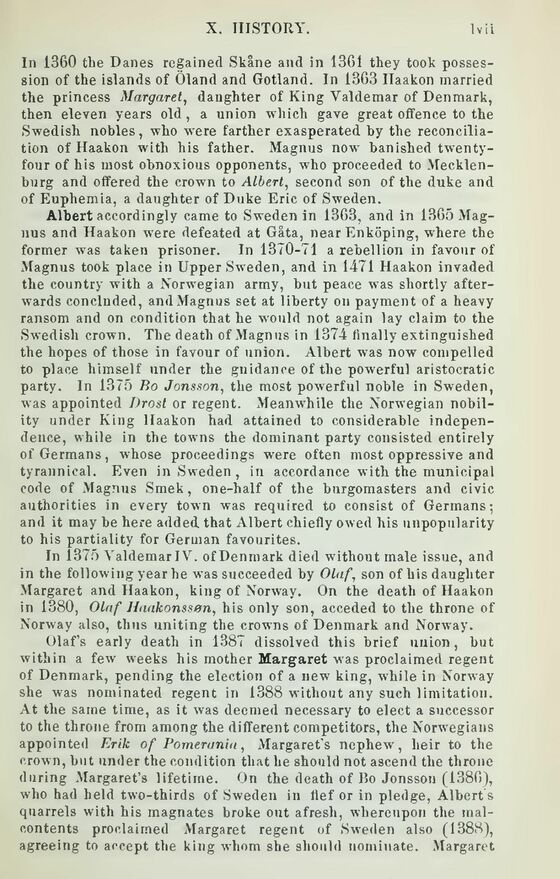
Full resolution (JPEG) - On this page / på denna sida - Introduction - Pages ...

<< prev. page << föreg. sida << >> nästa sida >> next page >>
Below is the raw OCR text
from the above scanned image.
Do you see an error? Proofread the page now!
Här nedan syns maskintolkade texten från faksimilbilden ovan.
Ser du något fel? Korrekturläs sidan nu!
This page has never been proofread. / Denna sida har aldrig korrekturlästs.
In 1360 the Danes regained Skåne and in 1361 they took
possession of the islands of Öland and Gotland. In 1363 Haakon married
the princess Margaret, daughter of King Valdemar of Denmark,
then eleven years old, a union which gave great offence to the
Swedish nobles, who were farther exasperated by the
reconciliation of Haakon with his father. Magnus now banished
twenty-four of his most obnoxious opponents, who proceeded to
Mecklenburg and offered the crown to Albert, second son of the duke and
of Euphemia, a daughter of Duke Eric of Sweden.
Albert accordingly came to Sweden in 1363, and in 1365
Magnus and Haakon were defeated at Gåta, near Enköping, where the
former was taken prisoner. In 1370-71 a rebellion in favour of
Magnus took place in Upper Sweden, and in 1471 Haakon invaded
the country with a Norwegian army, but peace was shortly
afterwards concluded, and Magnus set at liberty on payment of a heavy
ransom and on condition that he would not again lay claim to the
Swedish crown. The death of Magnus in 1374 finally extinguished
the hopes of those in favour of union. Albert was now compelled
to place himself under the guidance of the powerful aristocratic
party. In 1375 Bo Jonsson, the most powerful noble in Sweden,
was appointed Drost or regent. Meanwhile the Norwegian
nobility under King Haakon had attained to considerable
independence, while in the towns the dominant party consisted entirely
of Germans, whose proceedings were often most oppressive and
tyrannical. Even in Sweden , in accordance with the municipal
code of Magnus Smek, one-half of the burgomasters and civic
authorities in every town was required to consist of Germans;
and it may be here added that Albert chiefly owed his unpopularity
to his partiality for German favourites.
In 1375 ValdemarIV. ofDenmark died without male issue, and
in the following year he was succeeded by Olaf, son of his daughter
Margaret and Haakon, king of Norway. On the death of Haakon
in 1380, Olaf Haakonssen, his only son, acceded to the throne of
Norway also, thus uniting the crowns of Denmark and Norway.
Olaf’s early death in 1387 dissolved this brief union, but
within a few weeks his mother Margaret was proclaimed regent
of Denmark, pending the election of a new king, while in Norway
she was nominated regent in 1388 without any such limitation.
At the same time, as it was deemed necessary to elect a successor
to the throne from among the different competitors, the Norwegians
appointed Erik of Pomerania, Margaret’s nephew, heir to the
crown, but under the condition that he should not ascend the throne
during Margaret’s lifetime. On the death of Bo Jonsson (1386),
who had held two-thirds of Sweden in fief or in pledge, Albert’s
quarrels with his magnates broke out afresh, whereupon the
malcontents proclaimed Margaret regent of Sweden also (1388),
agreeing to accept the king whom she should nominate. Margaret
<< prev. page << föreg. sida << >> nästa sida >> next page >>